Nanotubes Market Size
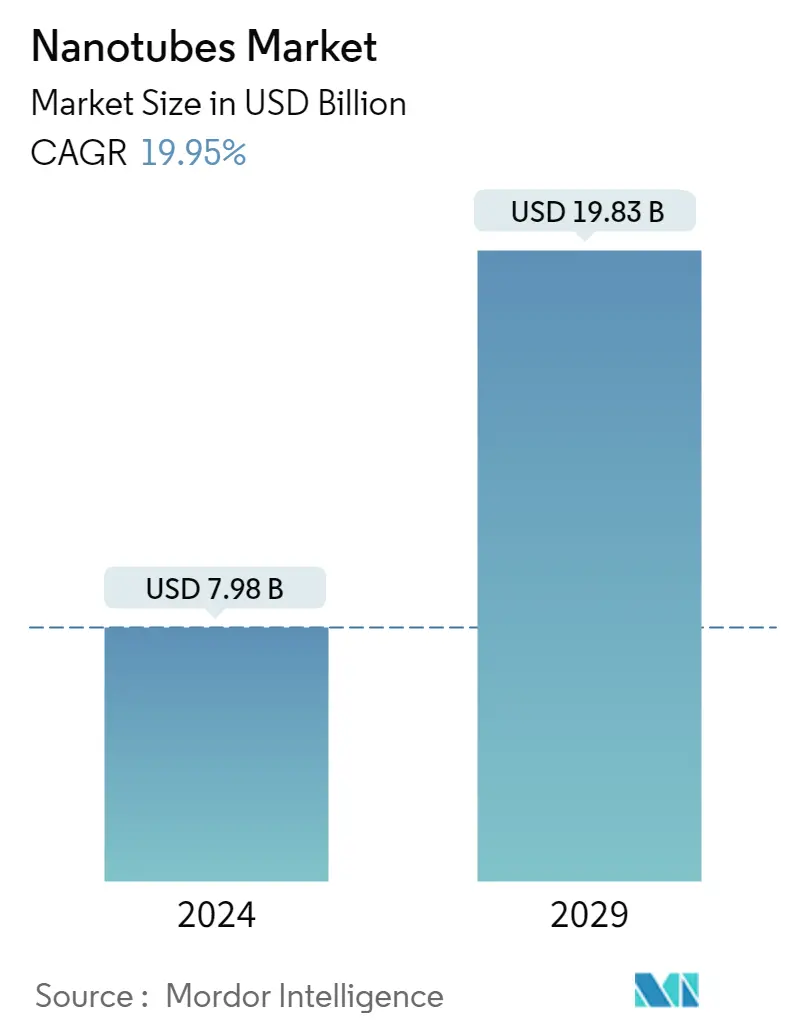
| Study Period | 2019 - 2029 |
| Market Size (2024) | USD 7.98 Billion |
| Market Size (2029) | USD 19.83 Billion |
| CAGR (2024 - 2029) | 19.95 % |
| Fastest Growing Market | Asia Pacific |
| Largest Market | Asia Pacific |
Major Players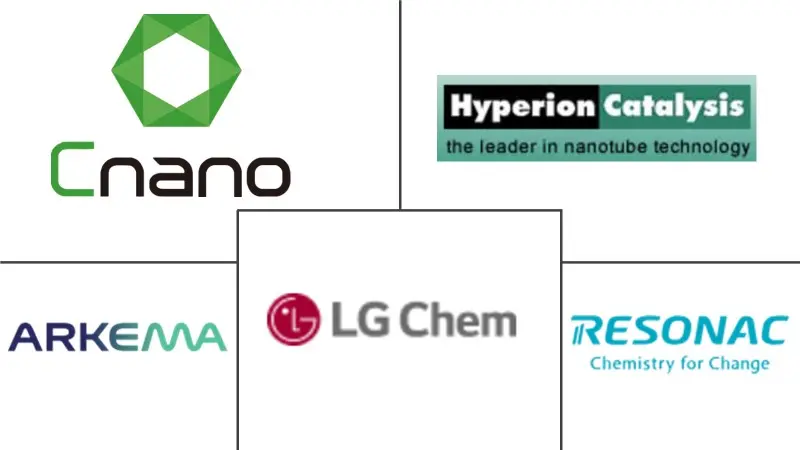
*Disclaimer: Major Players sorted in no particular order |
Nanotubes Market Analysis
The Nanotubes Market size is estimated at USD 7.98 billion in 2024, and is expected to reach USD 19.83 billion by 2029, growing at a CAGR of 19.95% during the forecast period (2024-2029).
The nanotubes market was negatively impacted by the COVID-19 pandemic as there was a slowdown in production and mobility, which caused a shortage of semiconductors, which negatively impacted the market for nanotubes. Also, industries such as electronics, energy, and aerospace were forced to delay their production due to containment measures and economic disruptions. Currently, the market has recovered from the pandemic. The market reached pre-pandemic levels in 2022 and is expected to grow steadily in the future.
The major factors driving the growth of the market studied are an advancement in nanotube technologies and the growing adoption of carbon nanotubes.
On the flip side, high manufacturing and R&D costs serve as one of the major stumbling blocks in the growth of the market studied.
Rising potential uses in electronic and storage devices are likely to provide opportunities for the market studied during the forecast period.
Asia-Pacific dominated the global market, as the increasing application and demand from industries such as electronics, energy, aerospace, and defense majorly drive the demand for nanotubes.
Nanotubes Market Trends
Electronics and Semiconductor Segment to Dominate the Market Demand
- Nanotubes find extensive application in the electronics industry, for the development of faster, more efficient, and more durable electronic devices.
- Among all the types of nanotubes, carbon nanotubes lead the market demand due to their applications in the electronics industry. Apart from carbon nanotubes, silicon nanotubes, and inorganic nanotubes are also used in the electronics industry.
- Carbon nanotubes find application in displays, large area surface conduction, color field emission displays, sensors, backlights for displays, traveling wave tubes, transistors, photovoltaics, conductive additives for non-display applications, photonics, radio-frequency identification (RFID) tags, neutron, and gamma-ray sources, and lighting devices.
- Silicon nanotubes contain hydrogen molecules and act like metal fuels. Thus, they are widely used for semiconductor applications in the electronics industry.
- Inorganic nanotubes are also used in the electronics industry for application in semiconductor devices, sensors, biosensors, nano-motors, and flat panel displays. Hence, owing to the diversified application of nanotubes in several electronic components, the demand for nanotubes is expected to increase.
- The increasing usage and widening arena of application in the electrical and electronics industry is expected to drive market growth.
- For instance, according to the Japan Electronics and Information Technology Industries Association (JEITA), the production by the global electronics and IT industry was estimated at USD 3,436.8 billion in 2022, registering a growth rate of 1% year on year, compared to USD 3,415.9 billion in 2021. Moreover, the industry is expected to reach USD 3,526.6 billion, with a growth rate of 3% year on year in 2023.
- According to the Semiconductor Industry Association (SIA), the global semiconductor industry sales totaled USD 574.1 billion in 2022, registering an increase of 3.3% compared to 2021 with USD 555.9 billion.
- Furthermore, on a regional basis, sales into the Americas market saw the largest increase (16.2%) in 2022. China remained the largest individual market for semiconductors, with sales there totaling USD 180.4 billion in 2022, a decrease of 6.2% compared to 2021. Moreover, annual sales also increased in 2022 in Europe (12.8%) and Japan (10.2%).
- This growth is expected to increase the demand for nanotubes for electronic applications in the region during the forecast period.
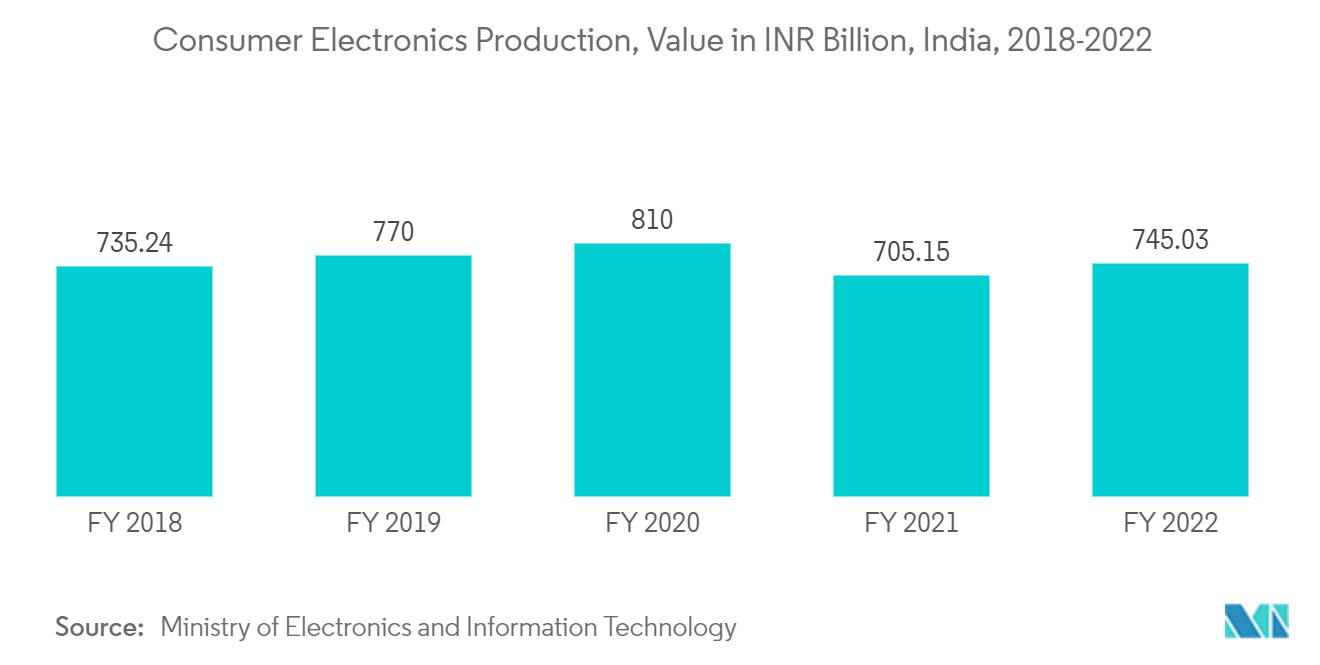
Asia-Pacific Region to Dominate the Market
- Asia-Pacific region dominated the global market share due to the increasing demand from industries such as electronics, energy, healthcare, aerospace and defense, and automotive.
- Japan is one of the largest producers of electronics; as per the Japan Electronics and Information Technology Industries Association (JEITA), the domestic production by the Japanese electronics industry was estimated at JPY 11,124.3 billion (USD 85.19 billion) in 2022, witnessing a growth rate of 2% compared to the previous year. The domestic production by the Japanese electronics industry is likely to reach JPY 11,402.9 billion (USD 87.32 billion) by 2023, registering a growth rate of 3% year-on-year.
- Moreover, according to the Ministry of Electronics and Information Technology, the production value of consumer electronics (TV, accessories, and audio) across India was above INR 745 billion (USD 9.46 billion) in fiscal year 2022. Thus supporting the growth of the market.
- Additionally, The Civil Aviation Administration of China (CAAC) has estimated the aviation sector to recover domestic traffic to around 85% of pre-pandemic levels. According to the Boeing Commercial Outlook 2023-2042, in China, around 8,560 new deliveries will be made by 2042, and the market service value will account for USD 675 billion by 2042. Owing to such new deliveries in the country, the demand for nanotubes in the aircraft sector will likely rise.
- Moreover, the market growth is further boosted by the growing automotive industry in the Asia-Pacific region. Developing countries such as China, India, Japan, and South Korea have been working hard to strengthen the manufacturing base and develop efficient supply chains for greater profitability in vehicle manufacturing.
- The Chinese government policy developments include the restriction of investments in new ICE-vehicle manufacturing plants and a proposal to tighten the average fuel economy of its light-duty passenger vehicle fleet by 2025.
- In addition, according to the Society of Indian Automobile Manufacturers (SIAM), a total of 3.79 million passenger vehicles were sold in India in 2022, witnessing a growth rate of around 23% compared to the passenger vehicles sold in the year 2021.
- Additionally, The Civil Aviation Administration of China (CAAC) has estimated the aviation sector to recover domestic traffic to around 85% of pre-pandemic levels. According to the Boeing Commercial Outlook 2023-2042, in China, around 8,560 new deliveries will be made by 2042, and the market service value will account for USD 675 billion by 2042.
- Hence, the trends above are expected to drive the demand for nanotubes in the region during the forecast period.
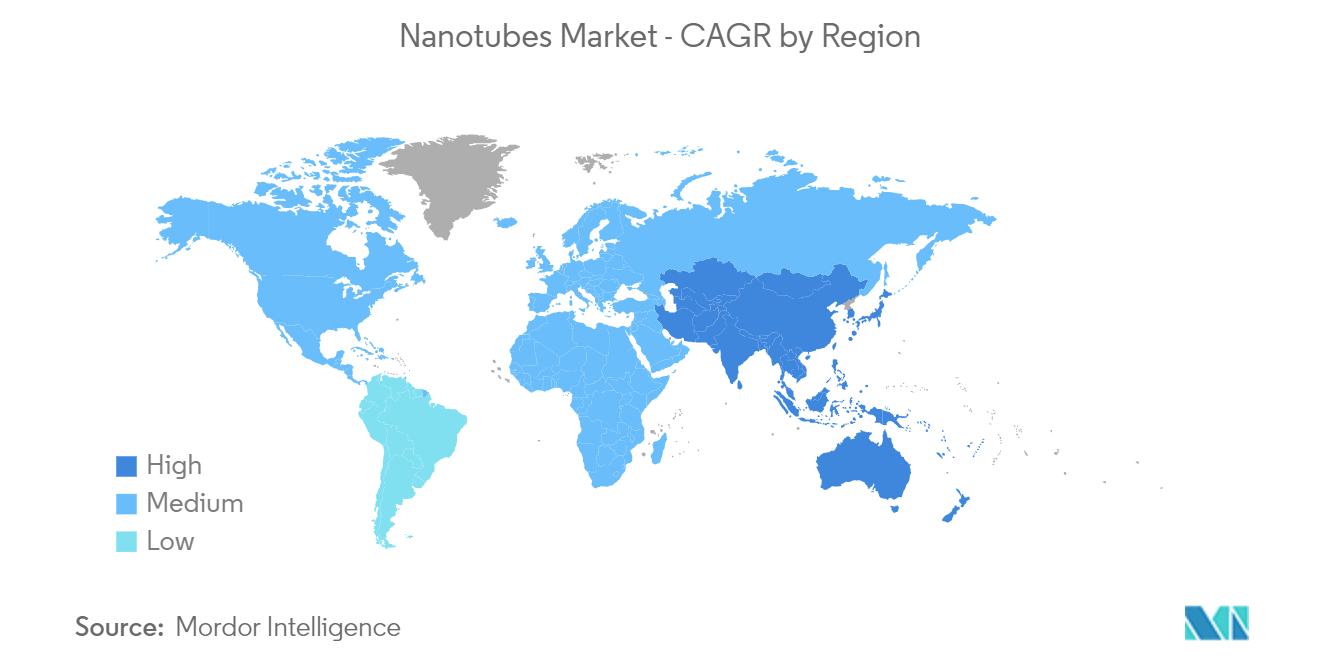
Nanotubes Industry Overview
The nanotubes market is fragmented in nature. The major players in the studied market (not in any particular order) include Arkema, Hyperion Catalysis International, Jiangsu Cnano Technology Co., Ltd, Resonac Holdings Corporation, and LG Chem, among others.
Nanotubes Market Leaders
-
Arkema
-
Hyperion Catalysis International
-
Jiangsu Cnano Technology Co., Ltd
-
Resonac Holdings Corporation
-
LG Chem
*Disclaimer: Major Players sorted in no particular order
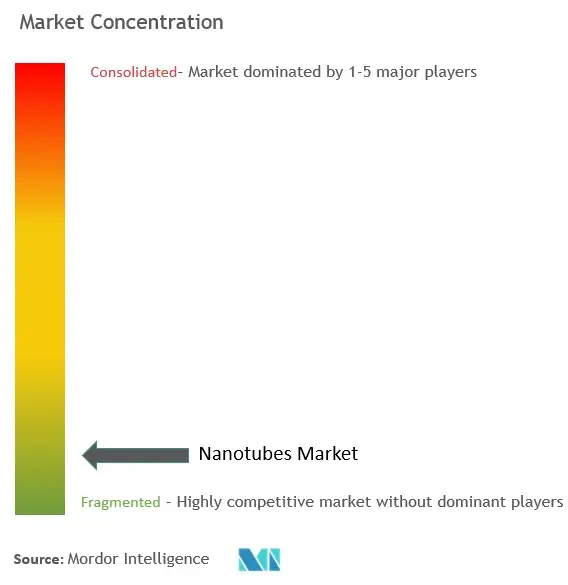
Nanotubes Market News
- October 2023: Birla Carbon (Aditya Birla Group) acquired Nanocyl SA to enhance its growth in battery materials for lithium-ion batteries, which will add value to its nanotubes business segment.
- May 2023: LG Chem started construction of its fourth carbon nanotube (CNT) plant at its Daesan Complex. The plant is expected to be operational in 2025 and will contribute to doubling LG Chem’s annual CNT production capability to 6,100 tons.
NanotubesMarket Report - Table of Contents
1. INTRODUCTION
- 1.1 Study Assumptions
- 1.2 Scope of the Study
2. RESEARCH METHODOLOGY
3. EXECUTIVE SUMMARY
4. MARKET DYNAMICS
-
4.1 Drivers
- 4.1.1 Advancement in Nanotubes Technologies
- 4.1.2 Growing Adoption of Carbon Nanotubes
- 4.1.3 Other Drivers
-
4.2 Restraints
- 4.2.1 High Manufacturing and R&D Cost
- 4.2.2 Other Restraints
- 4.3 Industry Value Chain Analysis
-
4.4 Porter's Five Forces Analysis
- 4.4.1 Bargaining Power of Suppliers
- 4.4.2 Bargaining Power of Buyers
- 4.4.3 Threat of Substitute Products and Services
- 4.4.4 Threat of New Entrants
- 4.4.5 Degree of Competition
5. MARKET SEGMENTATION (Market Size in Value)
-
5.1 Type
- 5.1.1 Carbon Nanotubes
- 5.1.2 Silicon Nanotubes
- 5.1.3 Inorganic Nanotubes
- 5.1.4 Other Types (Membrane Nanotubes, Etc.)
-
5.2 Structure Type
- 5.2.1 Non-polymer Organic Nanomaterials
- 5.2.2 Polymeric Nanomaterials
-
5.3 Application
- 5.3.1 Hydrogen Storage Devices
- 5.3.2 Sensors
- 5.3.3 Polymeric Biomaterials
- 5.3.4 Li-ion Batteries
- 5.3.5 Luminescent Display Devices
- 5.3.6 Biosensors
- 5.3.7 Nanoelectrodes
- 5.3.8 Water Purification Filters
- 5.3.9 Semiconductor Devices
- 5.3.10 Conductive Plastics
-
5.4 End-user Industry
- 5.4.1 Healthcare
- 5.4.2 Electronics
- 5.4.3 Energy
- 5.4.4 Automotive
- 5.4.5 Aerospace and Defense
- 5.4.6 Textile
- 5.4.7 Other End-user Industries (Chemical Materials, Etc.)
-
5.5 Geography
- 5.5.1 Asia-Pacific
- 5.5.1.1 China
- 5.5.1.2 India
- 5.5.1.3 Japan
- 5.5.1.4 South Korea
- 5.5.1.5 Rest of Asia-Pacific
- 5.5.2 North America
- 5.5.2.1 United States
- 5.5.2.2 Canada
- 5.5.2.3 Mexico
- 5.5.3 Europe
- 5.5.3.1 Germany
- 5.5.3.2 United Kingdom
- 5.5.3.3 France
- 5.5.3.4 Italy
- 5.5.3.5 Rest of Europe
- 5.5.4 South America
- 5.5.4.1 Brazil
- 5.5.4.2 Argentina
- 5.5.4.3 Rest of South America
- 5.5.5 Middle-East and Africa
- 5.5.5.1 Saudi Arabia
- 5.5.5.2 South Africa
- 5.5.5.3 Rest of Middle-East and Africa
6. COMPETITIVE LANDSCAPE
- 6.1 Mergers and Acquisitions, Joint Ventures, Collaborations, and Agreements
- 6.2 Market Share (%)**/Ranking Analysis
- 6.3 Strategies Adopted by Leading Players
-
6.4 Company Profiles
- 6.4.1 Arkema
- 6.4.2 Carbon Solutions Inc.
- 6.4.3 Cheap Tubes
- 6.4.4 Hyperion Catalysis International
- 6.4.5 Jiangsu Cnano Technology Co., Ltd.
- 6.4.6 Nano-C
- 6.4.7 Nanocyl SA (Birla Carbon)
- 6.4.8 NanoIntegris Inc.
- 6.4.9 Nanoshel LLC
- 6.4.10 Resonac Holdings Corporation
- 6.4.11 Thomas Swan & Co. Ltd
- 6.4.12 LG Chem
- *List Not Exhaustive
7. MARKET OPPORTUNITIES AND FUTURE TRENDS
- 7.1 Rising Potential Uses in Electronic and Storage Devices
- 7.2 Other Opportunities
Nanotubes Industry Segmentation
Nanotubes are small cylinders of atoms that are generally used for a wide range of applications owing to their electrical and mechanical properties. Different nanotubes have insulating, conducting, and semiconducting properties; among these, carbon nanotubes are mostly used. Carbon nanotubes have semiconductor properties that provide small transistors with high switching speeds, low electrical resistance, etc.
The nanotubes market is segmented by type, structure type, application, end-user industry, and geography. By type, the market is segmented into carbon nanotubes, silicon nanotubes, inorganic nanotubes, and other types (membrane nanotubes, etc.). By structure type, the market is segmented into non-polymer organic nanomaterials and polymeric nanomaterials. By application, the market is segmented into hydrogen storage devices, sensors, polymeric biomaterials, Li-ion batteries, luminescent display devices, biosensors, nanoelectrodes, water purification filters, semiconductor devices, and conductive plastics. By end-user industry, the market is segmented into healthcare, electronics, energy, automotive, aerospace and defense, textile, and other end-user industries (chemical materials, etc.). The report also covers the market size and forecasts for the market in 15 countries across the globe.
For each segment, the market sizing and forecasts have been done on the basis of value (USD).
| Type | Carbon Nanotubes | |
| Silicon Nanotubes | ||
| Inorganic Nanotubes | ||
| Other Types (Membrane Nanotubes, Etc.) | ||
| Structure Type | Non-polymer Organic Nanomaterials | |
| Polymeric Nanomaterials | ||
| Application | Hydrogen Storage Devices | |
| Sensors | ||
| Polymeric Biomaterials | ||
| Li-ion Batteries | ||
| Luminescent Display Devices | ||
| Biosensors | ||
| Nanoelectrodes | ||
| Water Purification Filters | ||
| Semiconductor Devices | ||
| Conductive Plastics | ||
| End-user Industry | Healthcare | |
| Electronics | ||
| Energy | ||
| Automotive | ||
| Aerospace and Defense | ||
| Textile | ||
| Other End-user Industries (Chemical Materials, Etc.) | ||
| Geography | Asia-Pacific | China |
| India | ||
| Japan | ||
| South Korea | ||
| Rest of Asia-Pacific | ||
| Geography | North America | United States |
| Canada | ||
| Mexico | ||
| Geography | Europe | Germany |
| United Kingdom | ||
| France | ||
| Italy | ||
| Rest of Europe | ||
| Geography | South America | Brazil |
| Argentina | ||
| Rest of South America | ||
| Geography | Middle-East and Africa | Saudi Arabia |
| South Africa | ||
| Rest of Middle-East and Africa |
NanotubesMarket Research FAQs
How big is the Nanotubes Market?
The Nanotubes Market size is expected to reach USD 7.98 billion in 2024 and grow at a CAGR of 19.95% to reach USD 19.83 billion by 2029.
What is the current Nanotubes Market size?
In 2024, the Nanotubes Market size is expected to reach USD 7.98 billion.
Who are the key players in Nanotubes Market?
Arkema, Hyperion Catalysis International, Jiangsu Cnano Technology Co., Ltd, Resonac Holdings Corporation and LG Chem are the major companies operating in the Nanotubes Market.
Which is the fastest growing region in Nanotubes Market?
Asia Pacific is estimated to grow at the highest CAGR over the forecast period (2024-2029).
Which region has the biggest share in Nanotubes Market?
In 2024, the Asia Pacific accounts for the largest market share in Nanotubes Market.
What years does this Nanotubes Market cover, and what was the market size in 2023?
In 2023, the Nanotubes Market size was estimated at USD 6.65 billion. The report covers the Nanotubes Market historical market size for years: 2019, 2020, 2021, 2022 and 2023. The report also forecasts the Nanotubes Market size for years: 2024, 2025, 2026, 2027, 2028 and 2029.
NanotubesIndustry Report
Statistics for the 2024 Nanotubes market share, size and revenue growth rate, created by Mordor Intelligence™ Industry Reports. Nanotubes analysis includes a market forecast outlook to for 2024 to 2029 and historical overview. Get a sample of this industry analysis as a free report PDF download.



